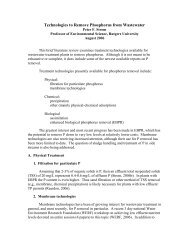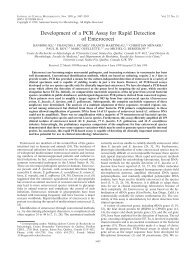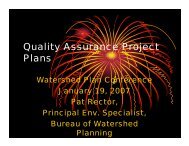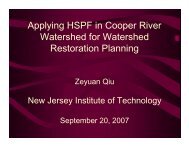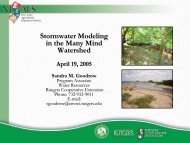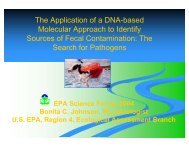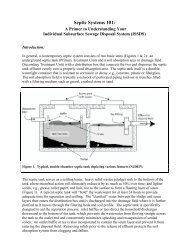Onsite Wastewater Treatment Systems: Alternative Technologies
Onsite Wastewater Treatment Systems: Alternative Technologies
Onsite Wastewater Treatment Systems: Alternative Technologies
You also want an ePaper? Increase the reach of your titles
YUMPU automatically turns print PDFs into web optimized ePapers that Google loves.
Advantages: The FAST system is particularly efficient atammonia and nitrate removal.Disadvantages: The FAST unit uses electricity and requiresoccasional maintenance of the motor.Purchase Cost: A FAST unit costs about $5,000. Aproperly sized septic tank costs about $2,000.Operation and Maintenance Cost: Typical costs areapproximately $300 per year. This amount includeselectricity and regular inspection costs.3. Recirculating Sand FilterThe Recirculating Sand Filter (RSF) utilizes an additionaltreatment stage beyond the conventional septic system(Figure 3). Effluent from the septic tank is pressurizedand sprayed on a volume of sand. Microorganisms breakdown organic matter and convert ammonia into nitrate asthe effluent filters through the sand. When the effluentreaches the under drain, a portion of the water enters thesoil absorption field and the rest re-circulates through theseptic tank, where the nitrates are converted into nitrogengas, an inert gas that can be vented to the atmosphere.Septic TankPump Chamber4/5 FlowSandSprayNozzlesSand FilterUnderdrainLeachingFacility1/5 FlowFigure 3. RSF Schematic (Massachusetts DEP, 1997)Advantages: Recirculating sand filters are extremelyefficient at reducing biochemical oxygen demand, totalsuspended solids, and ammonia and nitrate levels in arelatively small area.Disadvantages: Frequent inspection and maintenance isrequired to ensure proper functioning.Purchase Cost: The costs of an RSF are variable, dependingupon the cost of the sand media. An estimate isbetween $10,000 and $15,000.Operation and Maintenance Cost: $200 to $300 peryear, including electricity. The system must be inspectedand occasionally the top layer of sand must be removedfor optimal performance.4. Trickling FilterIn trickling filters (Figure 4), also known as fixed-filmreactors, microorganisms typically grow on a speciallydesigned synthetic material, such as a plastic polymer,instead of being carried with the liquid, as in a typicalseptic system.InfluentSepticTankFigure 4. Trickling Filter Schematic (Massachusetts DEP,1997)Advantages: Trickling filters can handle surges of flowto the system without losing the microbial communityresponsible for effluent treatment. They are extremelyeffective at reducing biochemical oxygen demand.Disadvantages: Trickling filters must be used as anadvanced treatment in conjunction with the septic tank.Purchase Cost: Equipment is about $9,000 includinginstallation.Operation and Maintenance Cost: Approximately$200 to $300 per year. The unit must be inspectedregularly by a professional.5. Sequencing Batch ReactorThe sequencing batch reactor (SBR) is particularly successfulat the removal of nitrate, phosphorus, and ammonia.The design principle consists of a series of processesthat occur in sequence in a single underground unit(Figure 5). During the treatment cycle no additionalinfluent is allowed to enter the unit.Septic TankOptional recirculation of effluentFixedfilmreactorOptional sludge returnClarifierSequenchingBatchReactorPump TankFigure 5. SBR Schematic (City of Austin, 2001)Effluent2



